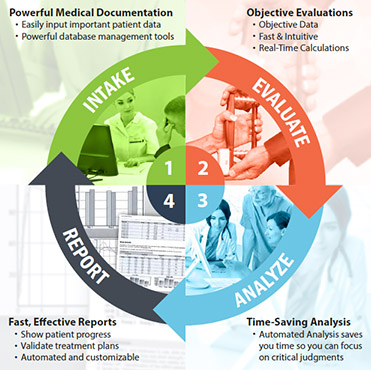JTECH BLOG



Communicate with Reliable, Reproducible, Objective Data

The world of personal injury and workers’ compensation can often be an adversarial environment. Without the right tools, it can be intimidating and challenging for healthcare providers to navigate. Many specialists, including Dr. Bagherian, depend on JTECH Medical systems in these situations to help them:
- Consistently capture reliable objective data
- Efficiently generate defensible documentation that is consistent with industry standards
- Optimize case outcomes
According to Dr. Bagherian,
"When I was first introduced to JTECH Medical, I was pleasantly surprised at how any healthcare provider, whether it be a surgeon, occupational therapist, physical therapist, or chiropractor, could objectively and empirically measure human performance with such a high degree of validity and reliability."
Read the full case study to hear more about how Dr. Bagherian
- Builds his practice on science
- Provides evidence for reimbursement
- Integrates a JTECH system into Medical Legal cases
- Protects the patient
- and global validation
Share this article:
COVID-19, Physical Therapy & Reimbursement: Telehealth in a Pandemic
The Novel Coronavirus (COVID-19) outbreak is creating a heavy burden on nearly every medical field. The same is true regarding the traditional hands-on relationship between physical therapists and their patients. Having a plan in place to provide for your patients while protecting them and your staff from the spread of infection is of utmost importance in this uncertain period.
The American Physical Therapy Association has published a new advisory regarding the use of telehealth in physical therapy clinics. While legislation recently enacted by Congress allows the Department of Health and Human Services to waive certain Medicare telehealth restrictions, questions remain regarding proper coding for reimbursement. To that end, APTA has provded additional guidance on the proper way to bill for telehealth services:
"There are not specific CPT codes for telehealth services furnished by physical therapists. Some therapists use codes in the 97000 series that best describe the services being provided and then use the place of service code "02" to indicate that the services were provided remotely. Because the CPT codes are direct contact codes it is important to verify that the payer allows you to use these codes when services are provided via telehealth, or if you must use a specific modifier. We also encourage you to check with each payer about using place-of-service code "02" when billing for telehealth services to specify the entity where service(s) were rendered."
Individual state laws still govern Medicaid coverage of telehealth services, so it's important to check with your state's existing regulations or for any recently enacted legislation due to the current COVID-19 outbreak.
The first priority in every clinic during pandemic should be the safety and welfare of your patients and staff. Take precautions and ensure you are following state and federal recommendations to help prevent the further spread of disease in your community.
Share this article:
Medical Device Integration Could Change Healthcare

As technology advances and the healthcare landscape becomes more complex, the benefits (and complications) of integrated EMR systems has been a big talking point. New research now indicates that the information from medical devices itself, when bridged across providers and systems, could be transformative for patient care. The biggest reason cited for not employing these systems? "No plan."
According to a past analysis from Frost & Sullivan, 50 percent of care providers do not have a plan for technology integration, even though the benefit of improved workflow, diagnostic aids, monitoring, and prevention have immediate and long-term value.
"More than 50 percent of healthcare providers do not have a healthcare IT roadmap, although they acknowledge the role of digital health in enhancing healthcare efficiency," said Frost & Sullivan Healthcare Research Analyst Shruthi Parakkal. "Consequently, even the existing interoperability standards such as HL7, DICOM and Direct Project are not being utilized optimally by many providers."
According to the study, solutions which allow interoperability between device vendors can go a long way in solving headaches for large (and presumably small) heathcare providers. Furthermore, the FDA is expected to "add thrust" to the development of interoperable devices and systems.
Are you working toward a more integrated healthcare environment? Have you experienced the benefits of integrated systems, or the drawbacks of operating several software solutions that don't integrate? Get in touch today to find out how JTECH Medical can help!
Read the Article JTECH Software Solutions
Share this article:
The Characteristics of a Quality FCE
 Functional capacity assessment is a burgeoning area of industrial medicine which is quickly moving into many other areas of physical medicine. If you've avoided them, or been uncertain how to manage the complex variables of a Functional Capacity Evaluation, it may be a matter of understanding the differences between a subpar FCE, and a quality FCE that would benefit all parties.
Functional capacity assessment is a burgeoning area of industrial medicine which is quickly moving into many other areas of physical medicine. If you've avoided them, or been uncertain how to manage the complex variables of a Functional Capacity Evaluation, it may be a matter of understanding the differences between a subpar FCE, and a quality FCE that would benefit all parties.
An article published by IBJI Rehabilitation, therapist Joe Castronovo highlights some of the differences between good and bad functional assessments in over 500 FCEs. The article has a lot of good food-for-thought for those who are performing functional assessments or who are considering them. In addition, Joe poses a few questions that administrators, legal counsel, and functional assessment professionals should consider.
- How many validity criteria does your FCE present?
- Is your FCE supported by scientific evidence and has the report (and therapist) held up in legal proceedings? Computer-based FCEs that are calibrated regularly help support the scientific evidence.
- How experienced is your therapist? How many tests has he or she performed? Is the tester a physical or occupational therapist, or someone with a different degree that may not be fully qualified to perform the exam?
- Is the therapist performing the test the treating provider?
- Does the report make a clear judgment on the person’s work ability compared to the worker’s actual job demands?
Check out the full article here, and find out how JTECH products can help provide tools to help you answer those questions the right way!
Read the Article JTECH FCE Systems
Share this article:
More Than Medical: Who Can Use Chiropractic Adjusting Tools
 When you hear the words "chiropractic adjusting tools," you likely think of equipment specifically designed to be used only in very specific circumstances. However, this isn't actually the case; these useful tools can be helpful in a variety of professional environments. With the many potential applications of chiropractic adjusting tools, professionals in many industries can make use of them on a regular basis. Here are a few ways that chiropractic adjusting tools can be useful in your field:
When you hear the words "chiropractic adjusting tools," you likely think of equipment specifically designed to be used only in very specific circumstances. However, this isn't actually the case; these useful tools can be helpful in a variety of professional environments. With the many potential applications of chiropractic adjusting tools, professionals in many industries can make use of them on a regular basis. Here are a few ways that chiropractic adjusting tools can be useful in your field:
Physical Therapy
Recently injured in your favorite sport? Many physical therapists use these back adjustment tools and physical therapy tools to help athletes recover and get back out onto the field faster. Chiropractic adjusting tools can help tackle scar tissue and muscle injuries, making them a key choice for any physical therapist looking to help patients get back to life as usual after an accident or injury.
Pain Management
In some situations, back pain and muscle pain is more than just a temporary issue. For patients with chronic pain, these chiropractic adjusting instruments can help treat ongoing pain. Worldwide, over 1.5 billion people suffer from chronic pain; many of these people specifically suffer from ongoing back pain. These tools can be incredibly helpful in managing a variety of chronic pain conditions, both for medical professionals as well as for patients to have at home.
Animal Health
Chiropractic adjusting instruments aren't just useful for humans; some veterinarians will even recommend them for pets who have suffered an injury. These tools allow for precision when addressing muscle and tissue problems, which can be helpful for animals where other methods might not be accurate or precise enough. Veterinarians can benefit greatly from adding these physical therapy tools to their practices.
While you might think of chiropractic adjustment tools as exclusively medical tools, they can be used by many different types of professionals in these industries and many more. These tools can be helpful for many people in need of equipment for addressing muscle pain. For more information on these rehab tools, as well as information on other types of functional assessment equipment and range of motion testing solutions, contact JTech Medical today.
Share this article: